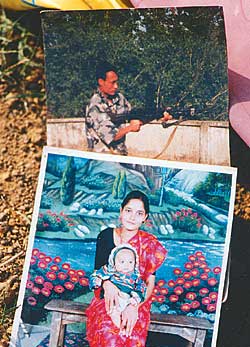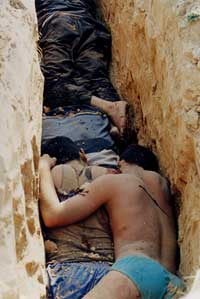 Five days after the attack on the police bases in Dang, vultures are still circling over the forests of Gojena along the Rapti river. Occasionally an army helicopter comes overhead, and the vultures scatter. Blood-stained bamboo stretchers used by Maoists to transport their dead and wounded lie along the east-west highway. There is a sickly smell of rotting corpses everywhere. Villagers walk around with handkerchiefs covering their faces, fearing an epidemic. There are no signs of health workers anywhere.
Five days after the attack on the police bases in Dang, vultures are still circling over the forests of Gojena along the Rapti river. Occasionally an army helicopter comes overhead, and the vultures scatter. Blood-stained bamboo stretchers used by Maoists to transport their dead and wounded lie along the east-west highway. There is a sickly smell of rotting corpses everywhere. Villagers walk around with handkerchiefs covering their faces, fearing an epidemic. There are no signs of health workers anywhere. By Wednesday, security forces had dug up more bodies-many in camouflage fatigues and tracksuits-taking the Maoist casualties in the battle to 92. Other freshly-dug graves are still being found along the Rapti. At least 150 people died in the Dang battles, and our post mortem reveals a tragic story of warnings unheeded, traumatised families, and diversionary attacks all over Dang aimed at keeping the army away.
This was the first attack on the newly-formed Armed Police Force, and it is hard to see why a 130-strong contingent of the paramilitary force should be posted in the tiny hamlet of Satbaria, except that it is the constituency of Home Minister Khum Bahadur Khadka. The village has no government offices, no health post, not even a post office. The police were housed in buildings belonging to Minister Khadka's family.
The surprising thing is that everyone we talked to in Satbaria said they were expecting a Maoist attack anytime before 17 March. Strangers had been passing through, and rumours were rife that the APF base would be the target. "We had noticed outsiders at the tea shop talking about a possible attack," a local resident told us. Some 30 or so villagers, including VDC chairman Dilli Bahadur Khadka, fled the village a few months before the attack, thinking the Maoists might target them for allowing the base to be set up in the village. Other families living near the base relocated a day before the attack.
Senior police officials in Kathmandu told us all vulnerable bases are on high alert, and there was no specific threat in Satbaria. Satbaria is located in a relatively secure area: it is on the main highway and there are other police and army bases within a 35 km radius. That could have given the APF a false sense of security. Still, villagers said they saw the armed police laying booby traps the evening before the attack, and also digging new trenches. Many bodies of police were found the next morning piled three high inside these trenches. When the base was overrun, the Maoists lined up the survivors and threatened to kill them if they didn't say who the inspector was. DSP Dhan Bahadur Basnet stepped forward, thinking the others would be spared. But other wounded police survivors tell us that all were lined up and shot dead.
The villagers woke up to sounds of gunfire and loud explosions at about 10:30 PM on Thursday. Children, the elderly and the sick huddled in what they considered the safest rooms in the house. Heads of households even dictated their wills and briefed family members on their assets and loans, fearing that they may not survive the night.
And it was a long and sleepless night. The sound of automatic weapons and explosives went on for five hours. The Satbaria post was surrounded by hundreds of heavily-armed Maoists. Diversionary attacks prevented reinforcements coming in from Ghorahi and Bhalubang. Residents heard a helicopter flying overhead several times. The gunfire would stop for a while, and resume when the helicopter flew away.
By morning, when the villagers finally felt it safe to come out, they saw bodies and blood everywhere. Five days later, the children still have vacant looks on their faces, they don't play around the houses, and they are all indoors by dusk. Parents told us their children were awake throughout the night, and many were too shocked to even cry.
 Said a local resident: "Every evening my four-year-old still asks me, bua will tonight also be like the other night. I tell him nothing will happen, but I am not sure myself." The children all suffer from nightmares, and they wake up in fright. There are rumours swirling all around, sometimes making it difficult to separate fact from fiction. The locals don't talk to strangers unless fully assured they will not be identified. The
Said a local resident: "Every evening my four-year-old still asks me, bua will tonight also be like the other night. I tell him nothing will happen, but I am not sure myself." The children all suffer from nightmares, and they wake up in fright. There are rumours swirling all around, sometimes making it difficult to separate fact from fiction. The locals don't talk to strangers unless fully assured they will not be identified. The only consolation the villagers of Satbaria have is that none of their own were killed
in the fighting.
Travelling from Ghorahi to Satbaria and Lamahi, we pieced together the events of that fateful night last week:
12 April, Thursday, 10:30 PM
Three powerful explosions go off at exactly the same time at the Katesnala bridge, about 100 m west of Bhalubang, where there is a paramilitary training centre. Another one blew up on the main road leading from Lamahi to Ghorahi, about 2 km from the main bazaar and close to the army barracks. Another one went off 500 m from the army camp at Tulsipur.
At about the same time, the Maoists arrived in large numbers at Lamahi, which is situated at the junction between the Dang road and the east-west highway. Using loud speakers, they warned residents at the bazar to remain indoors. Meanwhile at Satbaria, the first shots were being fired by the Maoists from the direction of Hattisar forests.
Thursday, 10:45 PM
Maoists set off three blasts at the electricity substation at Lamahi, plunging the entire district into darkness. There was an exchange of gunfire for about an hour in Ghorahi, Tulsipur and Bhalubang, and there were sounds of large explosions.
The Maoists moved towards the police station at Lamahi, located about 100 m off the highway and began shooting. In Satbaria, attacking Maoists were not just shooting from three directions, but also shouting slogans and calling out to encourage each other. In both attacks, Maoists used SLRs, light machine guns and rocket propelled grenades captured in previous raids. In Lamahi, these weapons were no match for the .303s of the civil police.
Friday, 12:15 AM
As fierce fighting continued in Satbaria, a civilian helicopter chartered by police flew in from Nepalganj and circled the battle scene. The Maoists shouted "bifal" (abort) and held fire for sometime. Encouraged that reinforcements had arrived by air, the police opened fire with their guns. But the helicopter found it too dangerous to land, and flew away.
By this time, the civil police base at Lamahi had been over-run. All nine civil police and an inmate in the lock-up were killed. The inspector, Padam Adhikary was tortured and beheaded.
Maoists engaged in that attack proceeded to Satbaria to join in the fight against the armed police. The firefight intensified, the armed police in the trenches ran out of ammunition and were mercilessly gunned down. The helicopter made a second over-flight, and the Maoists once more held fire. But two hours later the Satbaria base was nearly in their hands.
 Friday, 2:30 AM
Friday, 2:30 AM Residents had heard the voice of the police DSP Dhan Bahadur Basnet at Satbaria shouting orders in his loudspeaker all night, but suddenly his voice died. The gunfire from the camp also stopped. By this time, 37 paramilitary troopers lay dead, including DSP Basnet. Of about 112 policemen at the camp, some had absconded and some had deserted or were missing.
Friday, 3:45 AM
Sensing that victory was at hand, the Maoists started raising slogans. But it was a costly battle for the Maoists as well, more than 100 of their comrades also perished. Many of these were hardcore fighters pushed into a show-case attack designed for maximum publicity and to hit the morale of the security forces.
Satbaria villagers said they saw Maoists sifting through the dead looking for bodies and wounded from their side. The dead were carried on specially-designed dokos to trucks and tractors on the highway and taken to the Rapti River 1 km to the south.
Friday 7:00 AM
This went on till first light. "When we looked out of our windows, we could see Maoists in camouflage fatigues looking for and taking away the bodies of the dead, and wounded," one local villager told us.
At Satbaria and Lamahi, traumatised families started stepping out of their houses.
Friday, 12:00 noon
The first reinforcements arrive from Bhalubang and Nepalgunj after clearing obstructions along the highway. Police-chartered helicopters from Kathmandu land. Shops at Lamahi remained shut the whole day, and electricity was only restored in the evening. Two banks in Lamahi were also looted, and the Maoists took away 100 sacks of rice from a local trader in a hijacked truck. Other loot: 300 cartons of instant noodles, and 20 goats.
In Satbaria, the hundred or so police who survived were taken to Nepalgunj, and no sentries posted. So, the Maoists returned on Sunday night and ransacked Minister Khadka's house taking away grain from the store. The Home Minister had stopped by at his house on Saturday, and returned the same day.
On Monday, locals were still unsure what to expect. By now the wind from the east had begun carrying the stench of the bodies rotting in the Hattisar forest to the settlement in Ganeshpur. A 40-year-old there told us: "We did not think we would be alive, now we have all these corpses around us."
(Dadiram Subedi, Nirajan Khanal and Santosh Subedi assisted with reporting.)


